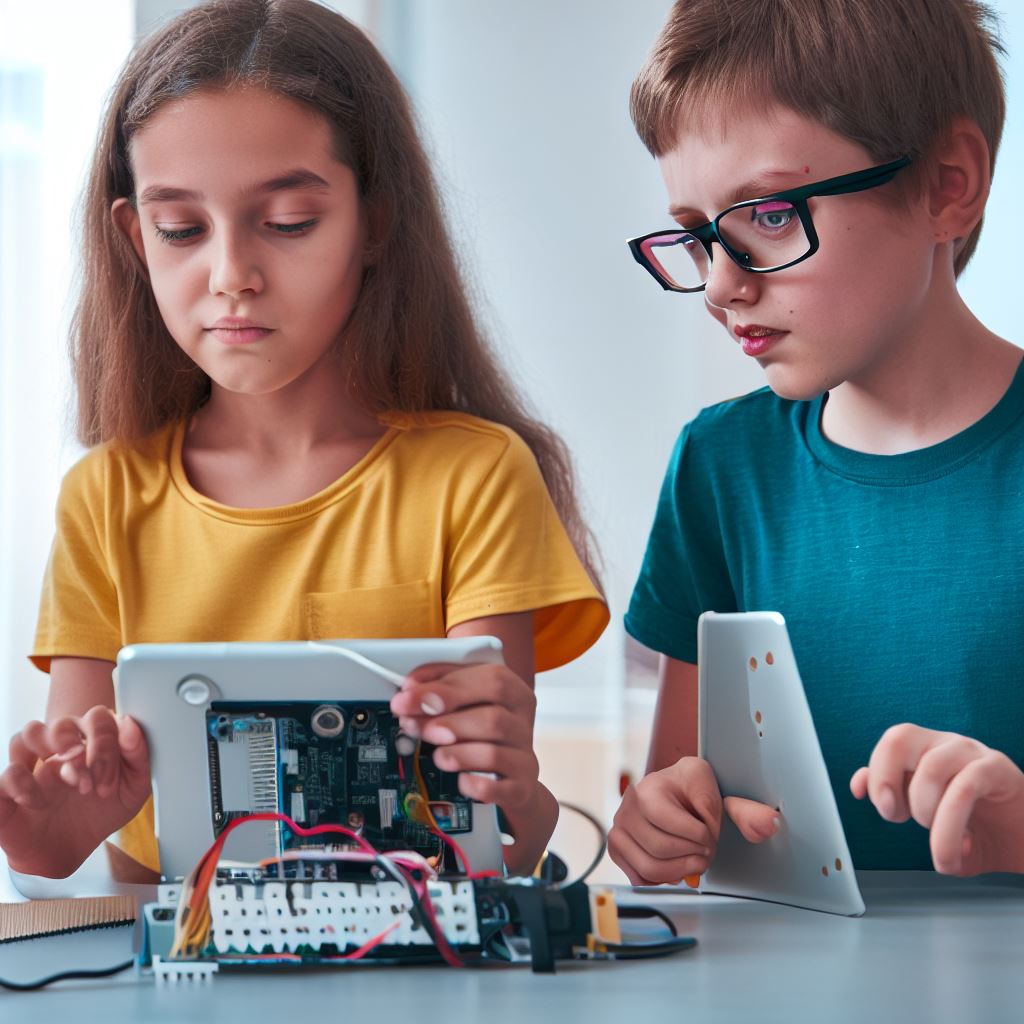Introduction
AI and machine learning play a crucial role in today’s world, shaping various industries and sectors.
The increasing demand for AI and machine learning skills makes it important for individuals to build a foundation in these areas from an early age.
This blog post aims to highlight the significance of introducing AI and machine learning to kids and teens and provide an overview of the content it covers.
AI and machine learning are transforming industries like healthcare, finance, education, and transportation.
The growing demand for AI and machine learning professionals creates abundant career opportunities.
By introducing AI and machine learning to kids and teens, we prepare them for the digital future.
In this blog post, we will delve into the basics of AI and machine learning concepts.
We will explore various interactive resources and tools that make learning AI and machine learning fun.
Additionally, we will discuss the benefits of incorporating AI and machine learning in educational curricula.
The post will also provide insights into how parents and teachers can support kids and teens in their AI and machine learning journey.
Furthermore, we will share success stories of young individuals who have achieved remarkable accomplishments in AI and machine learning.
By the end of this blog post, both parents and educators will understand the importance of teaching AI and machine learning to kids and teens.
Through this introduction, we have set the stage for an informative and engaging post that emphasizes the relevance of AI and machine learning in today’s world.
Why teach AI and Machine Learning to Kids and Teens?
Teaching Artificial Intelligence (AI) and Machine Learning (ML) to kids and teens is becoming increasingly important in today’s technologically advanced world.
Here are several compelling reasons why we should introduce these subjects to the younger generation:
Tech Consulting Tailored to Your Coding Journey
Get expert guidance in coding with a personalized consultation. Receive unique, actionable insights delivered in 1-3 business days.
Get StartedEnhancing critical thinking and problem-solving skills
- AI and ML require individuals to think analytically and critically when solving complex problems.
- By teaching kids and teens these concepts, we empower them to approach challenges with a logical mindset.
- They learn to break down problems into smaller components and devise innovative solutions.
Preparing for future job opportunities
- AI and ML are rapidly transforming various industries, and the demand for professionals in this field is growing.
- By introducing kids and teens to these concepts at an early age, we equip them with skills that will be highly sought after in the job market.
- They will have a competitive edge in the future and be well-prepared to pursue lucrative career opportunities.
Fostering creativity and innovation
- AI and ML encourage kids and teens to think creatively and find novel solutions to problems.
- These subjects provide a platform for young minds to explore their imaginations and invent new technologies.
- By nurturing their creativity, we inspire them to become future innovators and entrepreneurs.
Understanding the ethical implications of AI
- AI technologies are becoming increasingly prevalent in society, raising ethical concerns.
- Teaching kids and teens about the ethical aspects of AI ensures they become responsible users and creators of technology.
- They learn to consider the potential biases, privacy concerns, and societal impact of AI systems.
- Understanding these implications will enable them to shape a more ethical and inclusive future.
Basically, introducing AI and ML to kids and teens offers numerous benefits.
It enhances their critical thinking, prepares them for future job opportunities, fosters creativity and innovation, and helps them understand the ethical implications of AI.
By empowering the younger generation with these skills and knowledge, we can ensure a brighter and more technologically advanced future.
Read: Top 5 YouTube Channels for Kids to Learn Coding
Benefits of Learning AI and Machine Learning at a young age
1. Developing Logical and Computational Thinking Skills
- Learning AI and machine learning at a young age fosters logical thinking.
- Kids grasp the fundamentals of problem-solving through algorithmic approaches.
- They break complex problems into smaller, manageable components, honing their analytical skills.
- Computational thinking becomes second nature, enabling them to approach real-world challenges more effectively.
- AI instills a structured mindset, essential for organizing thoughts and tasks.
2. Enhancing Mathematical and Statistical Proficiency
- AI and machine learning rely heavily on mathematics and statistics.
- Kids naturally enhance their mathematical skills while working with algorithms.
- Probability, calculus, and linear algebra become familiar tools in their toolkit.
- Statistical analysis becomes a breeze, enabling data-driven decision-making.
- Math becomes a source of empowerment, not a source of fear.
3. Encouraging Interdisciplinary Learning
- AI transcends traditional boundaries, fostering interdisciplinary curiosity.
- Kids connect AI to various fields like healthcare, gaming, and environmental science.
- They discover the power of combining diverse knowledge for innovation.
- Understanding AI becomes a gateway to exploring multiple interests.
- Interdisciplinary thinking prepares them for the complex challenges of the future.
4. Nurturing a Growth Mindset and Resilience
- AI learning introduces kids to the world of trial and error.
- They learn that failures are stepping stones to success.
- Perseverance and resilience develop as they tackle AI projects.
- Mistakes are opportunities for improvement, nurturing a growth mindset.
- Kids become adaptable, ready to face any technological evolution with confidence.
In general, learning AI and machine learning at a young age offers a multitude of benefits.
It hones logical and computational thinking, enhances mathematical proficiency, encourages interdisciplinary learning, and nurtures a growth mindset.
These skills prepare kids and teens for a future where technology plays an increasingly central role in every aspect of life.
Read: Accessible Coding Classes for Kids with Special Needs
Approaches to Teaching AI and Machine Learning to Kids and Teens
1. Online resources and platforms
- Interactive websites and games can make learning AI and ML fun and engaging.
- Coding courses and tutorials provide step-by-step guidance for understanding and implementing AI and ML concepts.
- Virtual AI and ML experiments allow students to explore and experiment with AI algorithms in a simulated environment.
2. Robotics and physical computing
- Building and programming robots introduce kids and teens to the practical aspect of AI and ML.
- Hands-on projects with sensors and actuators help students understand how AI and ML can be applied in real-world scenarios.
- Incorporating AI and ML algorithms in physical devices allows students to see the direct impact of their programming on the hardware.
3. Project-based learning
- Identifying real-world problems that can be solved using AI solutions encourages critical thinking and problem-solving skills.
- Collaborative projects and group work foster teamwork and communication skills while developing AI and ML projects.
- Presenting and showcasing projects provide opportunities for students to demonstrate their knowledge and creativity in AI and ML.
By utilizing these approaches, educators can effectively teach AI and machine learning to kids and teens.
Read: Introducing Kids to Robotics Through Coding Classes

Challenges in Teaching AI and Machine Learning to Kids and Teens
Teaching AI and Machine Learning concepts to kids and teens can be a challenging task due to several factors:
Simplifying complex concepts for young learners
- Breaking down complex AI and Machine Learning concepts into simpler terms
- Using relatable examples and real-life applications to enhance understanding
- Adopting a step-by-step approach to gradually build knowledge and skills
Providing engaging and age-appropriate content
- Crafting curriculum and learning materials that capture the attention and interest of young learners
- Incorporating interactive activities, games, and projects to make learning enjoyable
- Aligning content with the cognitive abilities and developmental stages of the target age group
Overcoming stereotypes and encouraging diversity
- Breaking the misconception that AI and Machine Learning are only for certain genders or ethnicities
- Promoting inclusivity and equal participation in AI and Machine Learning programs
- Showcasing diverse role models and success stories in the field to inspire young learners
Addressing privacy and security concerns
- Teaching kids and teens about the importance of privacy and ethical use of AI and Machine Learning
- Explaining potential risks and how to protect personal data in the digital age
- Incorporating discussions on cybersecurity and the responsible use of AI technologies
Strategies towards overcoming Challenges
Despite these challenges, effective strategies can be employed to facilitate the teaching of AI and Machine Learning to kids and teens.
Firstly, educators can create a supportive and inclusive learning environment where all students feel valued and encouraged to explore AI and Machine Learning.
This can be achieved through classroom discussions, group collaborations, and mentorship programs.
Build Your Vision, Perfectly Tailored
Get a custom-built website or application that matches your vision and needs. Stand out from the crowd with a solution designed just for you—professional, scalable, and seamless.
Get StartedSecondly, utilizing gamification and interactive learning tools can significantly enhance engagement and comprehension.
By turning lessons into fun and interactive experiences, young learners are more likely to stay motivated and develop a love for AI and Machine Learning.
Thirdly, it is crucial to incorporate real-world applications and examples into the curriculum.
Demonstrating how AI and Machine Learning are used in various industries like healthcare, transportation, and entertainment can help young learners connect concepts to practical use cases.
Furthermore, involving industry professionals and experts in the teaching process can provide valuable insights and inspiration to young learners.
Guest lectures, workshops, and industry visits can expose students to the diverse possibilities and career opportunities in the field of AI and Machine Learning.
Lastly, addressing privacy and security concerns should be an integral part of the curriculum.
Educators can teach students about data protection, digital citizenship, and the responsible use of AI and Machine Learning technologies.
By promoting ethical practices, young learners can become responsible digital citizens and future innovators.
In essence, teaching AI and Machine Learning to kids and teens comes with its fair share of challenges.
However, by simplifying concepts, providing engaging content, encouraging diversity, and addressing privacy concerns, educators can effectively empower young learners with the knowledge and skills they need to succeed in the future.
Read: Should Coding be a Mandatory Subject in Schools?
Explore Further: Best Apps for Learning JavaScript: 2024 Edition
Best Practices for Teaching AI and Machine Learning to Kids and Teens
When it comes to teaching AI and machine learning to kids and teens, there are several best practices that can make the learning process more effective and enjoyable. These practices include:
Optimize Your Profile, Get Noticed
Make your resume and LinkedIn stand out to employers with a profile that highlights your technical skills and project experience. Elevate your career with a polished and professional presence.
Get NoticedHands-on and experiential learning activities
- Engage students in practical activities that allow them to directly interact with AI and machine learning technologies.
- Provide hands-on experience through building and programming simple AI models or robots.
- Encourage students to experiment and explore different solutions to real-world problems using AI and machine learning.
Storytelling and gamification techniques
- Introduce AI and machine learning concepts through interactive stories and games.
- Create fictional scenarios where AI technologies play a role, making the learning experience more engaging and relatable.
- Use gamification elements such as rewards, badges, and leaderboard to motivate students and make the learning process fun.
Breaking down concepts into bite-sized exercises
- Present complex AI and machine learning concepts in a simplified and understandable manner.
- Break down concepts into smaller, manageable exercises that gradually build upon each other.
- Provide clear explanations and examples to help students grasp the fundamental principles of AI and machine learning.
Encouraging peer-to-peer learning and collaboration
- Promote group activities and project-based assignments that foster collaboration among students.
- Encourage students to work together, share ideas, and learn from each other’s experiences.
- Assign group projects where students can apply AI and machine learning to solve real-world problems as a team.
By implementing these best practices, educators can create an engaging and effective learning environment for teaching AI and machine learning to kids and teens.
Hands-on activities allow students to experience AI technologies firsthand, fostering a deeper understanding of how they work.
Storytelling and gamification techniques make the learning process more enjoyable and relatable, capturing students’ interest and motivation.
Breaking down complex concepts into smaller exercises ensures that students can grasp the fundamental principles of AI and machine learning.
Finally, promoting peer-to-peer learning and collaboration encourages students to work together, share knowledge, and develop valuable teamwork skills.
Overall, the key is to make the learning experience interactive, relatable, and collaborative.
By incorporating these best practices, educators can inspire and empower the next generation to explore and embrace the world of AI and machine learning.
Conclusion
We have explored the benefits and approaches of AI and machine learning education for kids and teens.
These include cultivating critical thinking, problem-solving skills, and fostering creativity. It is imperative to emphasize the importance of such education in preparing the younger generation for the future.
By incorporating AI and machine learning in their curriculum, parents and educators can provide children with the necessary tools to thrive in a technology-driven world.
Let us encourage the integration of AI and machine learning into the educational system for the betterment of our children’s future.




